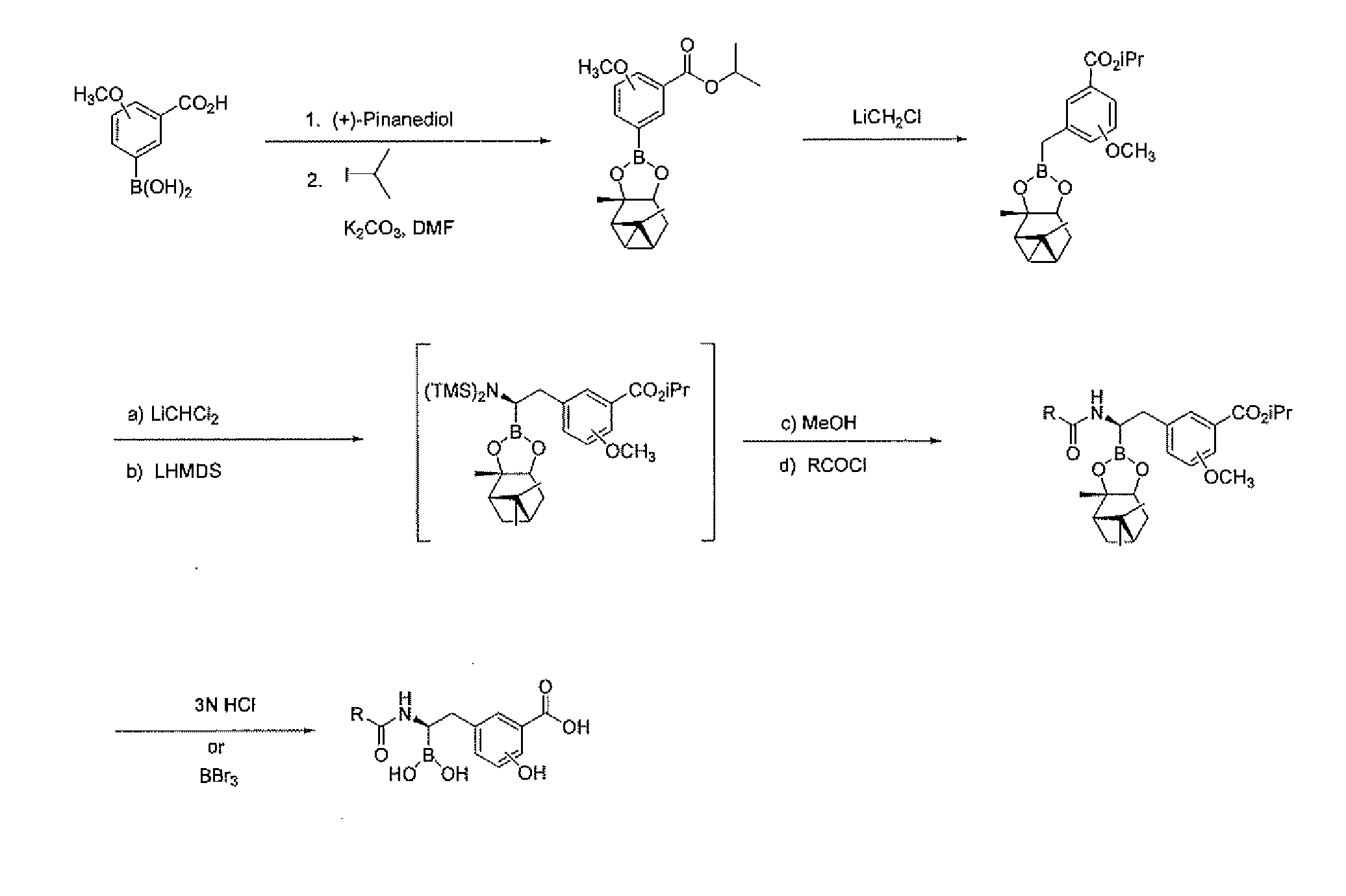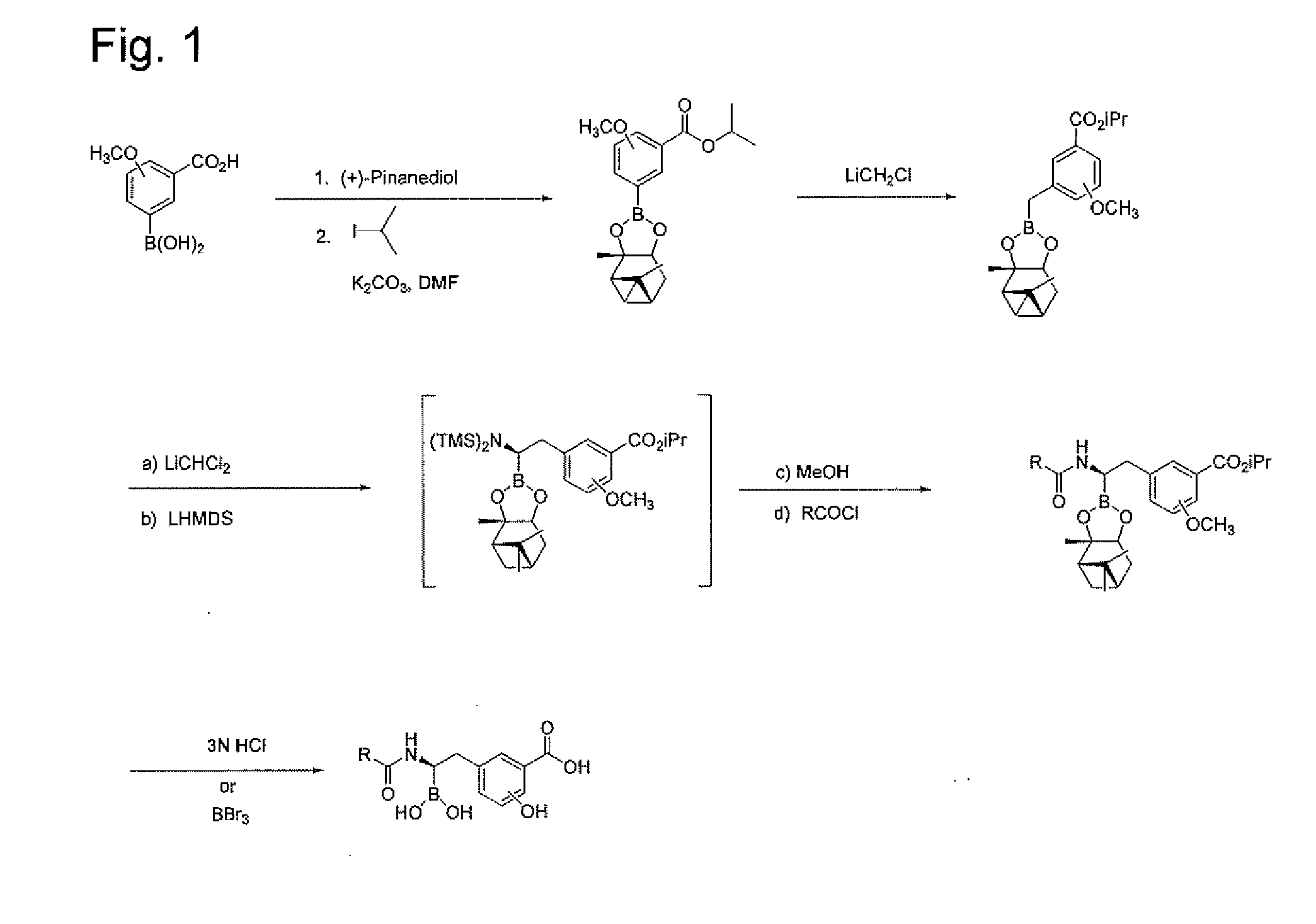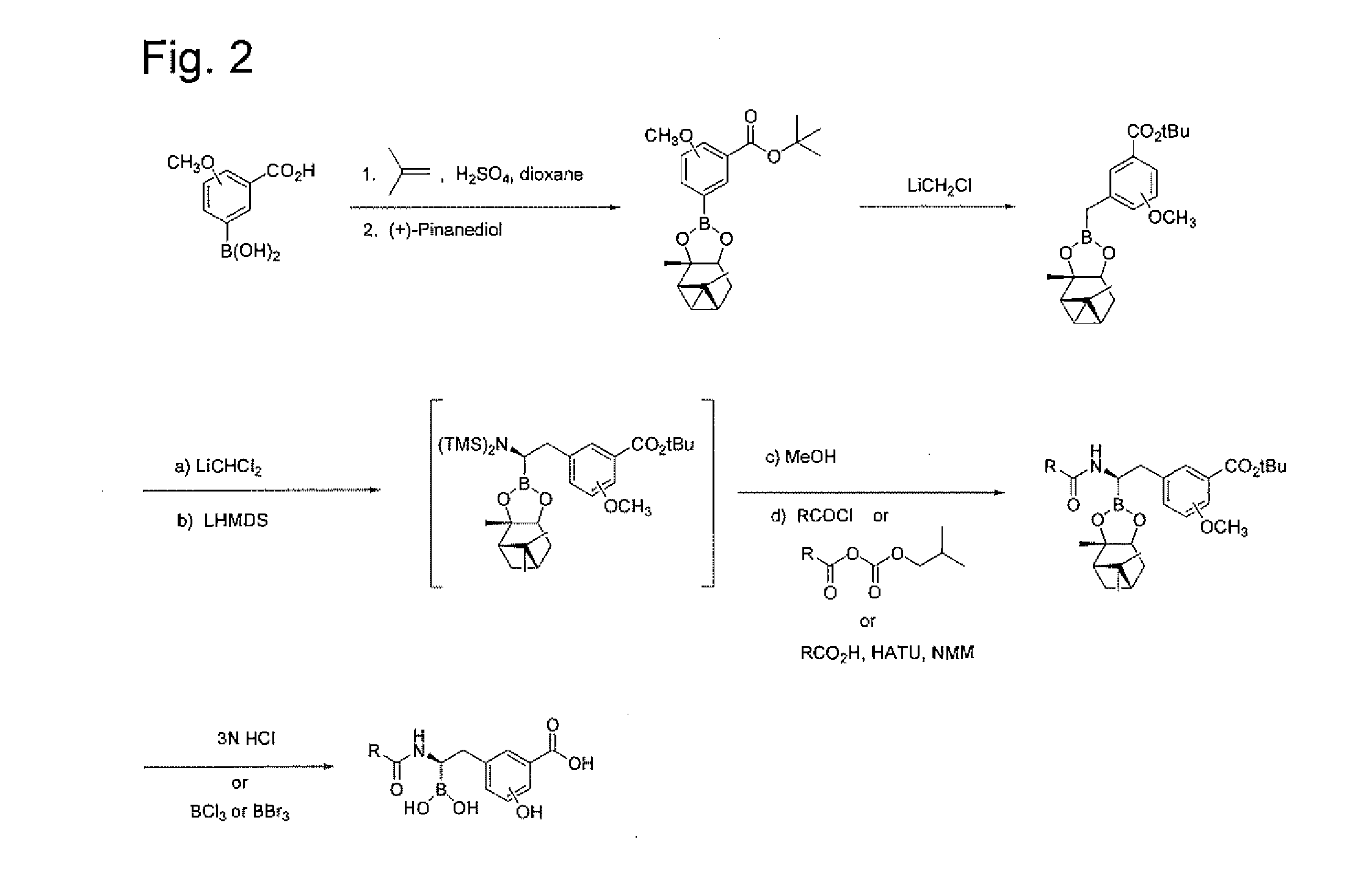Beta-lactamase inhibitors
a beta-lactamase and inhibitor technology, applied in the field of aminoboronic acids, can solve the problems of serious medical problems, limited beta-lactamase treatment options in the hospital and in the community, and diminishing utility
- Summary
- Abstract
- Description
- Claims
- Application Information
AI Technical Summary
Problems solved by technology
Method used
Image
Examples
example 1
(1R)-1-(2-thiophene-2-yl-acetylamino)-2-(2-hydroxy-3-carboxyphenyl)ethyl-1-boronic acid
[0235]Step 1. Synthesis of 2-Methoxy-3-(2,9,9-Trimethyl-3,5-dioxa-4-bora-tricyclo[6.1.1.02,6]dec-4-O-benzoic acid. A solution of (+)-pinanediol (17.4 g, 102.0 mmole) and 3-borono-2-methoxybenzoic acid (20.0 g, 102.4 mmole) in tetrahydrofuran (THF, 140 mL) was stirred for 15 h at ambient temperature. The solution was concentrated in vacuo, and the residue was washed with hexanes to afford 29.6 g (88%) of the product as a slowly crystallizing white solid. ESI-MS m / z 331 (MH)+.
[0236]Step 2. Synthesis of 2-Methoxy-3-(2,9,9-Trimethyl-3,5-dioxa-4-bora-tricyclo[6.1.1.02,6]dec-4-yl)-benzoic acid isopropyl ester. A solution of 2-methoxy-3-(2,9,9-trimethyl-3,5-dioxa-4-bora-tricyclo[6.1.1.02,6]dec-4-yl)-benzoic acid (22.3 g, 67.6 mmole), 2-iodopropane (13.5 mL, 13.5 mmole) and potassium carbonate (18.7 g, 13.5 mmole) in N,N-dimethylformamide (DMF, 337 mL) was stirred at ambient temperature for 18 h. The reac...
example 2
(1R)-1-(2-thiophene-2-yl-acetylamino)-2-(2-hydroxy-4-carboxyphenyl)ethyl-1-boronic acid
[0240]Step 1, Synthesis of 4-Methoxy-3-(2,9,9-Trimethyl-3,5-dioxa-4-bora-tricyclo[6.1.1.02,6]dec-4-yl)-benzoic acid. A solution of (+)-pinanediol (8.7, 51.0 mmole) and 3-borono-4-methoxybenzoic acid (10.0 g, 51.2 mmole) in THF (70 mL) was stirred for 30 min at room temperature. The solution was concentrated in vacuo, and the residue was washed with hexanes to afford 15.1 g (89%) of the product as a slowly crystallizing white solid. ESI-MS m / z 331 (MH)+.
[0241]Step 2, Synthesis of 4-Methoxy-3-(2,9,9-Trimethyl-3,5-dioxa-4-bora-tricyclo[6.1.1.02,6]dec-4-yl)-benzoic acid isopropyl ester. A solution of 4-methoxy-3-(2,9,9-trimethyl-3,5-dioxa-4-bora-tricyclo[6.1.1.02,6]dec-4-yl)-benzoic acid (15.0 g, 45.4 mmole), 2-iodopropane (9.1 mL, d=1.7, 90.7 mmole) and potassium carbonate (12.6 g, 90.7 mmole) in DMF (220 mL) was stirred at ambient temperature for 18 h. The reaction was quenched with water and extrac...
example 3
(1R)-1-(3-hydroxy-phenyl)acetylamino-1-(3-carboxy-2-hydroxy)benzyl-methyl boronic acid
[0245]Step 1. Synthesis of 3-Borono-2-methoxybenzoic acid tert-butyl ester. To a solution of 3-borono-2-methoxybenzoic acid (Combi-blocks, 5.0 g, 25.5 mmole) in 1,4-dioxane (30 mL) in a sealed tube was added conc. H2SO4 (1.5 mL). The solution was cooled to 0° C. and an equal volume of 2-methylpropene was bubbled in. The tube was sealed and allowed to stir at ambient temperature for 18 h. The solution was cooled in an ice bath, the seal was opened and the solution stirred at ambient temperature for 30 min. The solution was basified with saturated aq. NaHCO3 and extracted twice with EtOAc. The combined organic layers were washed with water (5×), brine, dried (Na2SO4) and concentrated in vacuo to afford 4.0 g (62%) of the product as a white solid. ESI-MS m / z 275 (M+Na)+.
[0246]Step 2. Synthesis of 2-Methoxy-3-(2,9,9-trimethyl-3,5-dioxa-4-bora-tricyclo[6.1.1.02,6]dec-4-yl)-benzoic acid tert-butyl ester....
PUM
| Property | Measurement | Unit |
|---|---|---|
| temperature | aaaaa | aaaaa |
| temperature | aaaaa | aaaaa |
| temperature | aaaaa | aaaaa |
Abstract
Description
Claims
Application Information
 Login to View More
Login to View More - R&D
- Intellectual Property
- Life Sciences
- Materials
- Tech Scout
- Unparalleled Data Quality
- Higher Quality Content
- 60% Fewer Hallucinations
Browse by: Latest US Patents, China's latest patents, Technical Efficacy Thesaurus, Application Domain, Technology Topic, Popular Technical Reports.
© 2025 PatSnap. All rights reserved.Legal|Privacy policy|Modern Slavery Act Transparency Statement|Sitemap|About US| Contact US: help@patsnap.com



